Basic Civil & Mechanical Engineering: UNIT II: o. Steel sections
Commercial forms or market forms of steel
Mild Steel has very high compressive and tensile strengths. It can be cut easily and welded. Hence, it is used for all civil engineering construction works.
COMMERCIAL FORMS or MARKET FORMS OF STEEL
Mild
Steel has very high compressive and tensile strengths. It can be cut easily and
welded. Hence, it is used for all civil engineering construction works.
In
order to use in building construction works, steel should be available in
certain forms, known as Commercial Forms or Market Forms. These
are:
Round
Bars, Square Bars, Torsteel Bars, Plates, Flats, Angle Sections, Channel
Sections, I/T/H Sections, Cross Section, Bulb T-section, Bulb Angle Section,
Flat Footed Rail Section, Train Rail Section, etc.
Built-up
Sections: Using these, a still wider variety of
sections can be built-up such as Box girder, Plate girder, Plated beam, etc.,
for taking greater loads over longer spans in the structures.
1.
Bars
See
Figs. 9(i) and (ii). Steel Bars have Round (6 to 32 mm diameter) or Square (6
to 32 mm sides) cross sections.
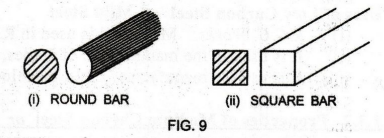
Uses
Round
bars are used in Reinforced concrete and Reinforced brick work constructions. Square
bars are used as Railings in buildings and for Grills, Gates, etc.
2.
Plates: Rolled Steel Plates are available in thickness of 5
mm to 28 mm. [Plates thinner than 5 mm are called Sheets.]
Uses:
Plates are used as Webs and Flanges for Column flanges, Column bases, Deep
beams, etc.
3.
Flats: Flats are like plates, but with narrow width. Flats
are costlier than plates.
Uses:
Flats are used in the fabrication of grills, gates and railings.
4.
Angle Sections
See
Figs. 10(i) and (ii). Rolled Steel Angles may be of Equal legs or Unequal legs.
Thickness is same for both the legs. These are available in different sizes.
Uses: Angle sections are used in the construction of Steel roof trusses,
Columns, Beams, Built-in beams, Steel bridges and as Stiffeners in big girders.
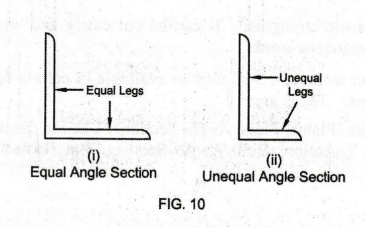
5.
Double Angle Section (Z-Section)
See
Fig. 11. It shows a Double Angle Section. It is also known as Z-Section.
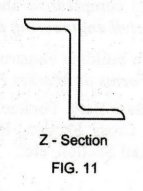
Uses:
Z-Sections are used in Structural steel works.
6.
Channel Sections
See
Fig. 12. Channel Section is in the form of C. It consists of a Web and two
equal Flanges. It is designated by the height of the web and width of the
flange.
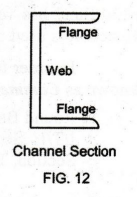
Uses:
Channel Sections are used in Roof trusses, Built-in columns, Beams, Crane
girders, Steel bridges and various types of Structural members of steel-framed
structures.
7.
I-Section
See
Fig. 13. This section is named, based on its shape. I-Sections are also called
Rolled Steel Joists (R.S.J.). An I-Section consists of a Web connecting two
Flanges. It is designated by its overall depth, width of flange and weight per
meter length. These are available in various sizes.
Uses:
I-Sections are used for Beams, Lintels, Columns, Built-up girders, etc.
Heavyweight with unequal I-Sections are used as Rails.
8.
T-Section
See
Fig. 14. This section is also named, based on its shape. A T-Section consists
of a Web and a Flange. It is designated by the overall dimensions and thickness
of web and flange. These are available in various sizes.
Uses:
T-Sections are used in Steel roof trusses, Steel chimneys, Steel bridges, etc.,
and to form Built-up sections. These are also used in T-Connections in Steel
water tanks.
9.
H-Section: See Fig. 15. This section is also named, based on
its shape.
Uses:
It is used for Columns in building constructions. It is available in various
sizes.
10.
Cross Section: See Fig. 16. It is a special type of
Structural steel section.
11.
Bulb T-Section:
See
Fig. 17. It is a special T-Section with a Bulb at bottom edge of Web.
12.
Bulb Angle Section
See
Fig. 18. It is also a special type of Rolled steel section used in Steel
constructions.
13.
Flat Footed Rail Section: See Fig. 19. This section is used
for Railings.
14.
Train Rail Section: See Fig. 20. It is also a special type
of Rail section.
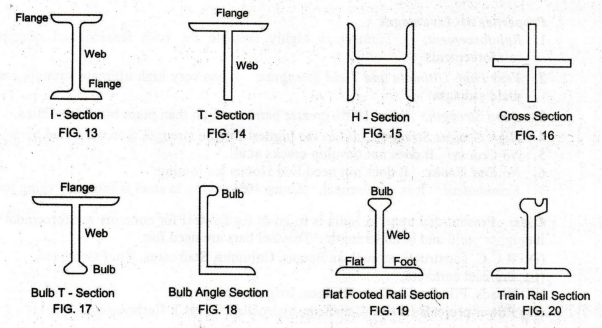
1. STEEL AS A REINFORCING
MATERIAL
1.
Properties of Steel as a Reinforcing Material
-
Steel has high tensile strength and high modulus of elasticity.
-
Steel forms a monolithic structure on reinforcement with concrete.
-
Steel is available as round or flat bars and sections like I, T, H, Channel,
Angle, etc.
-
Steel develops a very good bond with concrete,
-
Temperature coefficient of expansion and contraction of steel is the same as
that of concrete. Therefore, thermal stresses do not develop at all in R.C.C.
2.
Types of Reinforcing Steel Bars
•
Plain Mild Steel Bars: Plain Mild Steel Bars conforming to IS :
432 have been used in earlier constructions of reinforced concrete structures.
•
Deformed Bars: Deformed bars rolled with small
projections on the surface are more often used, instead of smooth bars. This is
because of the added gripping strength.
•
Torsteel Bars: Torsteel Bars are twisted deformed
bars. They carry ‘TOR' mark on its surface. See Fig. 21.
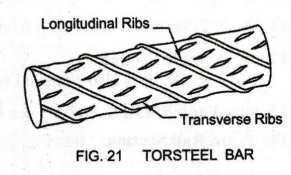
Torsteel
bars have Longitudinal Ribs (small projections) in the form of continuous or Longitudinal
Ribs - discontinuous helix and Transverse Ribs, spaced at uniform intervals.
Thus, the torsteel bars are also known as Ribbed Torsteel Bars.
Both
the ribs help in developing higher bond due to the interlock between steel and
concrete.
Properties
or Advantages
1.
Reinforcement: Torsteel is highly suitable for both tension and compression reinforcements.
2.
Very High Ultimate and Yield Strengths. It has very high ultimate strength and
high yield strength.
3.
Bond Strength: It has 100% greater bond strength than plain Mild Steel Bars.
4.
High Fatigue Strength: It has the highest fatigue strength than deformed bars.
5.
No Cracks: It does not develop cracks at all. :
6.
No End Hooks: It does not need End Hooks for joining.
7.
Economical: It is economical. About 40% saving in steel is found by using
torsteel.
Uses:
Present day trend in India is to go in for torsteel for concrete reinforcement
due to its higher yield and bond strength. Torsteel bars are used for:
(i)
R.C.C. constructions such as Beams, Columns, Staircases, Roof slabs, etc.
(ii)
Pre-cast concrete,
(iii)
Roads, Pile foundations, Bridges, Irrigation projects,
(iv)
Power projects (thermal, nuclear, hydroelectric, etc.), Harbors, etc.
Basic Civil & Mechanical Engineering: UNIT II: o. Steel sections : Tag: : - Commercial forms or market forms of steel
Related Topics
Related Subjects
Basic Civil and Mechanical Engineering
BE3255 2nd Semester 2021 Regulation | 2nd Semester EEE Dept 2021 Regulation
